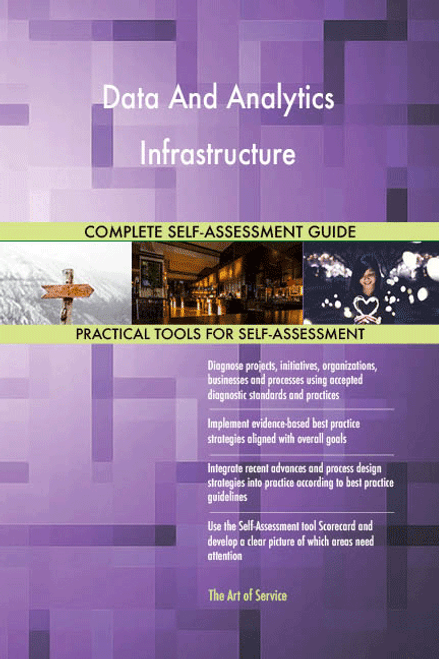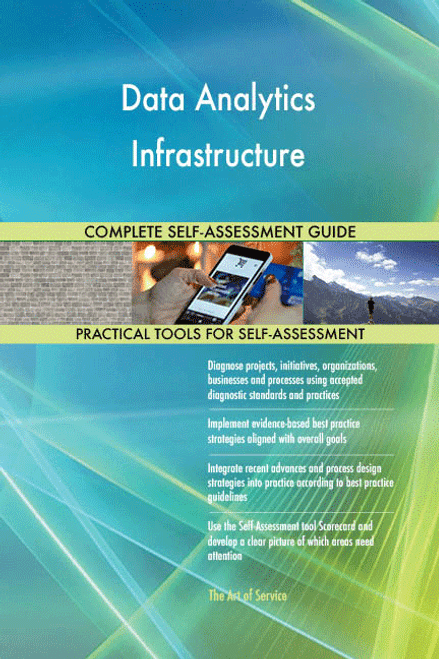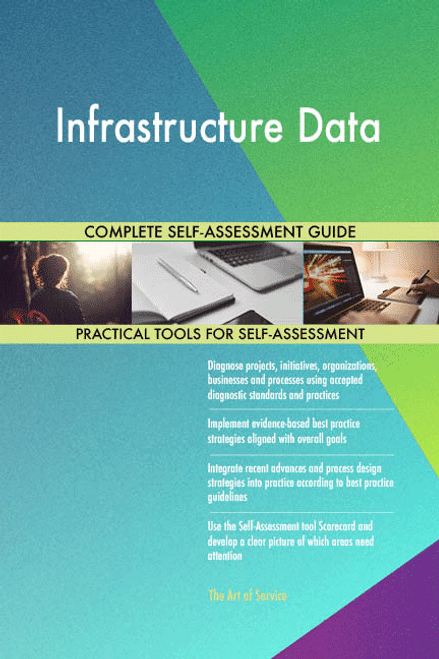Head Data And Analytics Infrastructure: review Test Standards, prepare designs, procure materials, collect and analyze data, prepare reports.
More Uses of the Data And Analytics Infrastructure Toolkit:
- Investigate Data Quality issues to determine root cause, resolve any Data Issues and recommended process change to prevent reoccurrence.
- Confirm your planning complies; efforts, working with clients to validate migrated data, working with Agile Development teams to understand changes and impacts towards Data Migration efforts, among other tasks.
- Capture data SOX Compliance and maintain related reports.
- Navigate steer your efforts to utilize MetaData Management tools, Data Quality tools, etc to operationalize and scale your Data Governance capabilities.
- Be accountable for reporting and monitoring of Data Capture for automation and maintenance activities.
- Standardize Data And Analytics Infrastructure: partner with marketing to gather data through the digital client journey and nurture new clients through Content Marketing.
- Establish that your organization participates in all phases of the development lifecycle, with significant participation in the Data Integration design and development, advocating for standardization, reviewing performance results, and preparing for implementations.
- Integrate applications with a very large existing system and technical ecosphere ensuring seamless integration of new and existing systems to eliminate potential problems and maintain Data Structure and integrity.
- Maintain Strategic Management system (sms) entries for the oee, document oee sms Best Practices, conduct sms training, integrate Data Collection and oee portal visualization of sms outputs, and develop appropriate measures for oee effectiveness.
- Establish that your design operates Data Capture technology to import digitized documents into Document Management system.
- Confirm your organization complies; designs and ensures the recoverability of lost data through proper and adequate backup and Data Recovery methods.
- Your responsibility is to stay ahead of the complexity inherent in scaling a Distributed System that handles over half a million correlated financial instruments across multiple Data Centers and thousands of servers, all the while striving for simplicity and Operational Excellence.
- Manage requirements discovery, Solution Design, user story writing, feature development, and User Acceptance Testing.
- Arrange that your organization builds high end analytic models, utilizing supervised and unSupervised Learning models, to support decision makers with Data Driven insights that address immediatE Business problems and objectives.
- Govern Data And Analytics Infrastructure: review data from the Quality Management System to track performance at team and individual level to provide actionable data to the Management Team.
- Create, communicate, and maintain an inspiring and clear strategy, roadmap, and architecture for your machinE Learning and data platform technology.
- Ensure your design communicates sales data and market relevant insights with distributor partners.
- Ensure you invent; build production grade models on large scale datasets to optimize marketing performance by utilizing advanced Statistical Modeling, machinE Learning, or Data Mining techniques and marketing science research.
- Manage to get there, you obsess over iteratively delivering customer value through rapid prototyping and Data Driven Decision Making.
- Collaborate with Data Architects and DevOps.
- Perform controller database conversions maintaining Data integrity using Standard Operating Procedures (Sops) and existing timing plans.
- Make sure that your business understands and can articulate the value and business advantage of Data Center virtualization techniques and cloud architectures.
- Be certain that your corporation complies; partners with Supply Chain to match unit pricing and clear quantity exceptions and related purchase order issues.
- Manage Data And Analytics Infrastructure: confirmation of entered data, and confirmation that data provided meets the minimum requirements as indicated by the QMS.
- Ensure your project oversees the confidentiality, integrity, and availability of enterprise data without disrupting Digital Transformation and growth.
- Manage work with the Cloud Professional Services group to support virtual connections to various Virtual Private Cloud (VPC) from the Data Centers.
- Be accountable for creating Data Quality Scorecards on various attributes to grade the Source Data to the golden record (completeness, accuracy, duplication, consistency, conformity, integrity), and Data Analyst tool allows Data Stewards to choose components, create and refresh Scorecards.
- Write, and/or edit materials summarizing Data Collection methods and research findings.
- Identify trends and opportunities to develop strategies and implement Data Driven solutions to improve tools, systems and policies.
- Analyze mapping data and make decisions based on policy to complete mapping workflows.
- MeasurE Business impact, and draw the connection between what teams are building and how IT impacts organization metrics.
- Collaborate with thE Business analysts and/or Business Intelligence and Analytics team to perform detailed Data Analysis and develop the Data Models that comprise the enterprise Data Warehouse.
- Manage to support a mission Critical Infrastructure and ensure the highest levels of availability, performance, and security.
- Devise Data And Analytics Infrastructure: partner with internal and external SMEs and coordinate cross functional collaborations/meetings to ensure completeness/accuracy in documentation and meet the defined quality, content and timelines.
Save time, empower your teams and effectively upgrade your processes with access to this practical Data And Analytics Infrastructure Toolkit and guide. Address common challenges with best-practice templates, step-by-step Work Plans and maturity diagnostics for any Data And Analytics Infrastructure related project.
Download the Toolkit and in Three Steps you will be guided from idea to implementation results.
The Toolkit contains the following practical and powerful enablers with new and updated Data And Analytics Infrastructure specific requirements:
STEP 1: Get your bearings
Start with...
- The latest quick edition of the Data And Analytics Infrastructure Self Assessment book in PDF containing 49 requirements to perform a quickscan, get an overview and share with stakeholders.
Organized in a Data Driven improvement cycle RDMAICS (Recognize, Define, Measure, Analyze, Improve, Control and Sustain), check the…
- Example pre-filled Self-Assessment Excel Dashboard to get familiar with results generation
Then find your goals...
STEP 2: Set concrete goals, tasks, dates and numbers you can track
Featuring 999 new and updated case-based questions, organized into seven core areas of Process Design, this Self-Assessment will help you identify areas in which Data And Analytics Infrastructure improvements can be made.
Examples; 10 of the 999 standard requirements:
- What is the problem and/or vulnerability?
- What methods are feasible and acceptable to estimate the impact of reforms?
- How can you incorporate support to ensure safe and effective use of Data And Analytics Infrastructure into the services that you provide?
- Is the cost worth the Data And Analytics Infrastructure effort?
- How much data can be collected in the given timeframe?
- Is it possible to estimate the impact of unanticipated complexity such as wrong or failed assumptions, feedback, etc. on proposed reforms?
- Does a Data And Analytics Infrastructure quantification method exist?
- Do those selected for the Data And Analytics Infrastructure team have a good general understanding of what Data And Analytics Infrastructure is all about?
- Is the Data And Analytics Infrastructure organization completing tasks effectively and efficiently?
- What are the costs and benefits?
Complete the self assessment, on your own or with a team in a workshop setting. Use the workbook together with the self assessment requirements spreadsheet:
- The workbook is the latest in-depth complete edition of the Data And Analytics Infrastructure book in PDF containing 994 requirements, which criteria correspond to the criteria in...
Your Data And Analytics Infrastructure self-assessment dashboard which gives you your dynamically prioritized projects-ready tool and shows your organization exactly what to do next:
- The Self-Assessment Excel Dashboard; with the Data And Analytics Infrastructure Self-Assessment and Scorecard you will develop a clear picture of which Data And Analytics Infrastructure areas need attention, which requirements you should focus on and who will be responsible for them:
- Shows your organization instant insight in areas for improvement: Auto generates reports, radar chart for maturity assessment, insights per process and participant and bespoke, ready to use, RACI Matrix
- Gives you a professional Dashboard to guide and perform a thorough Data And Analytics Infrastructure Self-Assessment
- Is secure: Ensures offline Data Protection of your Self-Assessment results
- Dynamically prioritized projects-ready RACI Matrix shows your organization exactly what to do next:
STEP 3: Implement, Track, follow up and revise strategy
The outcomes of STEP 2, the self assessment, are the inputs for STEP 3; Start and manage Data And Analytics Infrastructure projects with the 62 implementation resources:
- 62 step-by-step Data And Analytics Infrastructure Project Management Form Templates covering over 1500 Data And Analytics Infrastructure project requirements and success criteria:
Examples; 10 of the check box criteria:
- Cost Management Plan: Eac -estimate at completion, what is the total job expected to cost?
- Activity Cost Estimates: In which phase of the Acquisition Process cycle does source qualifications reside?
- Project Scope Statement: Will all Data And Analytics Infrastructure project issues be unconditionally tracked through the Issue Resolution process?
- Closing Process Group: Did the Data And Analytics Infrastructure Project Team have enough people to execute the Data And Analytics Infrastructure Project Plan?
- Source Selection Criteria: What are the guidelines regarding award without considerations?
- Scope Management Plan: Are Corrective Actions taken when actual results are substantially different from detailed Data And Analytics Infrastructure Project Plan (variances)?
- Initiating Process Group: During which stage of Risk planning are risks prioritized based on probability and impact?
- Cost Management Plan: Is your organization certified as a supplier, wholesaler, regular dealer, or manufacturer of corresponding products/supplies?
- Procurement Audit: Was a formal review of tenders received undertaken?
- Activity Cost Estimates: What procedures are put in place regarding bidding and cost comparisons, if any?
Step-by-step and complete Data And Analytics Infrastructure Project Management Forms and Templates including check box criteria and templates.
1.0 Initiating Process Group:
- 1.1 Data And Analytics Infrastructure project Charter
- 1.2 Stakeholder Register
- 1.3 Stakeholder Analysis Matrix
2.0 Planning Process Group:
- 2.1 Data And Analytics Infrastructure Project Management Plan
- 2.2 Scope Management Plan
- 2.3 Requirements Management Plan
- 2.4 Requirements Documentation
- 2.5 Requirements Traceability Matrix
- 2.6 Data And Analytics Infrastructure project Scope Statement
- 2.7 Assumption and Constraint Log
- 2.8 Work Breakdown Structure
- 2.9 WBS Dictionary
- 2.10 Schedule Management Plan
- 2.11 Activity List
- 2.12 Activity Attributes
- 2.13 Milestone List
- 2.14 Network Diagram
- 2.15 Activity Resource Requirements
- 2.16 Resource Breakdown Structure
- 2.17 Activity Duration Estimates
- 2.18 Duration Estimating Worksheet
- 2.19 Data And Analytics Infrastructure project Schedule
- 2.20 Cost Management Plan
- 2.21 Activity Cost Estimates
- 2.22 Cost Estimating Worksheet
- 2.23 Cost Baseline
- 2.24 Quality Management Plan
- 2.25 Quality Metrics
- 2.26 Process Improvement Plan
- 2.27 Responsibility Assignment Matrix
- 2.28 Roles and Responsibilities
- 2.29 Human Resource Management Plan
- 2.30 Communications Management Plan
- 2.31 Risk Management Plan
- 2.32 Risk Register
- 2.33 Probability and Impact Assessment
- 2.34 Probability and Impact Matrix
- 2.35 Risk Data Sheet
- 2.36 Procurement Management Plan
- 2.37 Source Selection Criteria
- 2.38 Stakeholder Management Plan
- 2.39 Change Management Plan
3.0 Executing Process Group:
- 3.1 Team Member Status Report
- 3.2 Change Request
- 3.3 Change Log
- 3.4 Decision Log
- 3.5 Quality Audit
- 3.6 Team Directory
- 3.7 Team Operating Agreement
- 3.8 Team Performance Assessment
- 3.9 Team Member Performance Assessment
- 3.10 Issue Log
4.0 Monitoring and Controlling Process Group:
- 4.1 Data And Analytics Infrastructure project Performance Report
- 4.2 Variance Analysis
- 4.3 Earned Value Status
- 4.4 Risk Audit
- 4.5 Contractor Status Report
- 4.6 Formal Acceptance
5.0 Closing Process Group:
- 5.1 Procurement Audit
- 5.2 Contract Close-Out
- 5.3 Data And Analytics Infrastructure project or Phase Close-Out
- 5.4 Lessons Learned
Results
With this Three Step process you will have all the tools you need for any Data And Analytics Infrastructure project with this in-depth Data And Analytics Infrastructure Toolkit.
In using the Toolkit you will be better able to:
- Diagnose Data And Analytics Infrastructure projects, initiatives, organizations, businesses and processes using accepted diagnostic standards and practices
- Implement evidence-based Best Practice strategies aligned with overall goals
- Integrate recent advances in Data And Analytics Infrastructure and put Process Design strategies into practice according to Best Practice guidelines
Defining, designing, creating, and implementing a process to solve a business challenge or meet a business objective is the most valuable role; In EVERY company, organization and department.
Unless you are talking a one-time, single-use project within a business, there should be a process. Whether that process is managed and implemented by humans, AI, or a combination of the two, it needs to be designed by someone with a complex enough perspective to ask the right questions. Someone capable of asking the right questions and step back and say, 'What are we really trying to accomplish here? And is there a different way to look at it?'
This Toolkit empowers people to do just that - whether their title is entrepreneur, manager, consultant, (Vice-)President, CxO etc... - they are the people who rule the future. They are the person who asks the right questions to make Data And Analytics Infrastructure investments work better.
This Data And Analytics Infrastructure All-Inclusive Toolkit enables You to be that person.
Includes lifetime updates
Every self assessment comes with Lifetime Updates and Lifetime Free Updated Books. Lifetime Updates is an industry-first feature which allows you to receive verified self assessment updates, ensuring you always have the most accurate information at your fingertips.







